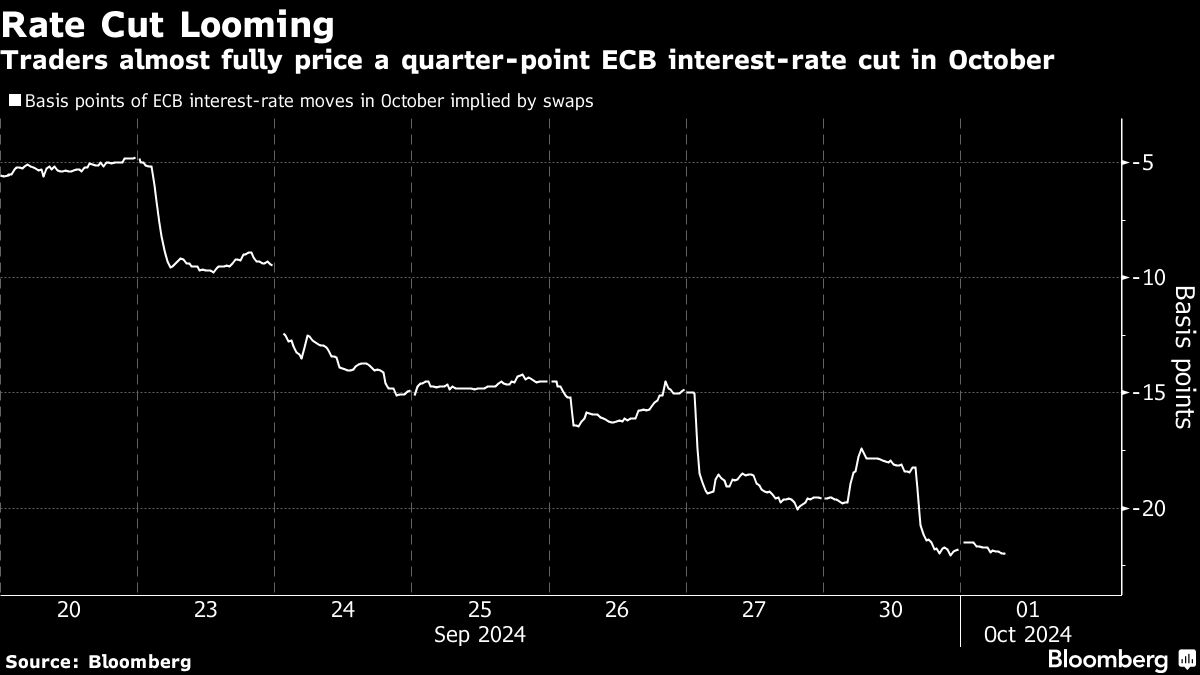
(Oct 1): Government bonds rallied and traders positioned for swifter interest-rate cuts in Europe, as signs grow the region’s economy is in need of looser monetary policy.
French bonds, which have suffered from the nation’s political impasse led the moves on Tuesday, driving the 10-year yield to the lowest level since March. US Treasuries followed suit, with the 10-year yield dropping four basis points.
European Central Bank’s (ECB) Olli Rehn hinted the bank would consider cutting interest rates again when it sets policy this month. He was the latest policymaker to raise the possibility of back-to-back reductions.
Rates traders are quickly coming around to the idea that the global easing cycle may be bolder than previously expected, and are bidding up bonds before interest rates fall further. The market had already been toying with the prospect of a second half-point cut from the Federal Reserve (Fed), and is now positioning for consecutive reductions in Europe too.
“The ECB needs to get cracking, the economy is weak just look at the data we got out of Germany,” said Karen Ward, the chief market strategist for Europe, Middle East and Africa at JPMorgan Asset Management on Bloomberg TV.
The rally was compounded by speculation France’s Michel Barnier will reveal up to €18 billion (US$20 billion or RM83 billion) of additional taxes when he delivers his first speech as the prime minister to Parliament at 3pm in Paris, making progress towards meeting the European Union’s demand for fiscal consolidation.
Data Tuesday showed euro-area inflation eased below the ECB’s 2% target for the first time since 2021 in September, the latest sign that activity is cooling and price pressures that dogged economies for years are now firmly back under control. Meanwhile, concerns about Germany are on the rise.
The outlook for the manufacturing sector in the euro-area’s biggest economy is particularly dire, and the government in Berlin is set to lower its economic-growth forecast for this year, expecting stagnation at best following a full-year contraction in 2023.
A quarter-point ECB cut in October — a fringe risk just weeks ago — is now almost fully priced. Against this backdrop, a host of banks have recently revised their forecasts. JPMorgan Chase & Co, Goldman Sach Group Inc and Barclays Bank plc all see the ECB cutting rates in October, compared to December previously.
In the US, money markets imply a one-in-three chance the Fed will deliver another half-point cut in November, and are pricing a total of about 190 basis points of easing by the end of next year.
Stretched bets
Still, BlackRock Inc chief executive officer Larry Fink said the market is pricing too many interest-rate cuts from the Fed, given that the US economy continues to grow, adding that most government policies at the moment are more inflationary than deflationary.
Fed chair Jerome Powell on Monday said the central bank will lower interest rates “over time”, while again emphasising that the overall US economy remains on solid footing.
The yield on French 10-year bonds fell as much as 11 basis points to 2.81%. The equivalent German rate fell eight basis points to 2.05%, the lowest level since January. The euro slipped as much as 0.5% to US$1.11084.
Easing inflation pressures and a deteriorating eurozone economy support the case for an interest-rate cut this month, ECB member Rehn said on Tuesday. President Christine Lagarde indicated on Monday that the ECB is becoming more optimistic that it will be able to get inflation under control.
“The notion that an inflation-concerned ECB would move more carefully than the Fed on easing is crumbling,” said Francesco Pesole, a currency strategist at ING Bank NV.
Uploaded by Tham Yek Lee

